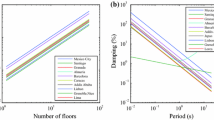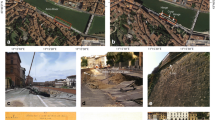Abstract
This study aims at presenting the analyses of monitoring data that have been used in the context of structural monitoring and Earthquake Early Warning (EEW) for a hospital building in Thessaloniki. Permanent and temporary instrumentation arrays, implemented under the responsibility of Aristotle University of Thessaloniki (SDGEE-AUTH) in close cooperation with German Centre for Geosciences (GFZ) are presented. The ambient noise data recorded at the temporarily installed networks are used for the dynamic characterization of the building based on both vibrational and waveform approaches. Moreover, long-term ambient noise recordings from the permanent array installed within the hospital are used for the investigation of the daily and seasonal wandering of the building resonance frequencies related to environmental effects. The modal identification results are used in a comprehensive framework for the computation of the up-to-date fragility curves representing the actual structural state considering aging effects of the construction materials, possible pre-existing damages and changes in the geometry and mass distribution. The building-specific fragility functions are integrated into two independent EEW systems and rapid damage assessment approaches, namely the PRESTo software and an onsite EEW algorithm on the instruments of the permanent array, to provide the expected level of damage after strong ground shaking at the monitored building. The implemented monitoring networks and the developed operational tools can be used in the context of seismic risk mitigation and preparedness for structural safety assessment under earthquake loading.














Similar content being viewed by others
References
Allemang RJ, Brown DL (1982) A correlation coefficient for modal vector analysis. In: Proceedings of the 1st international modal analysis conference, vol 1, pp 110–116. SEM, Orlando
Anastasiadis A, Raptakis D, Pitilakis K (2001) Thessaloniki’s detailed microzoning: subsurface structure as basis for site response analysis. Pure Appl Geophys 158:2597–2633
Baker JW, Cornell CA (2005) A vector-valued ground motion intensity measure considering of spectral acceleration and epsilon, earthquake engineering & structural dynamics. Stanford University, USA
Banks HT, Inman DJ, Leo DJ, Wang Y (1996) An experimentally validated damage detection theory in smart structures. J Sound Vib 191(5):859–880
Bindi D, Petrovic B, Karapetrou S, Manakou M, Boxberger T, Raptakis D, Pitilakis KD, Parolai S (2015a) Seismic response of an 8-story RC-building from ambient vibration analysis. Bull Earthq Eng 13(7):2095–2120
Bindi D, Boxberger T, Orunbaev S, Pilz M, Stankiewicz J, Pittore M, Iervolino I, Ellguth E, Parolai S (2015b) On-site early-warning system for Bishkek (Kyrgyzstan). Ann Geophys 58(1):1–8
Bindi D, Iervolino I, Parolai S (2016) On-site structure-specific real-time risk assessment: perspectives from the REAKT project. Bull Earthq Eng. doi:10.1007/s10518-016-9889-4
Brincker R, Zhang L, Andersen P (2000) Modal identification from ambient responses using frequency domain decomposition. In: Proceedings of the 18th international modalanalysis conference, San Antonio, Texas
CEN (2004) Eurocode 8: design of structures for earthquake resistance—part 1: general rules, seismic actions and rules for buildings. European Committee for Standardization, Brussels
Chopra AK (1996) Modal analysis of linear dynamic systems: physical interpretation. J Struct Eng 122:517–527
Clinton JF, Bradford SC, Heaton TH, Favela J (2006) The observed wander of the natural frequencies in a structure. Bull Seismol Soc Am 96(1):237–257
Guéguen P, Michel C, Le Corre L (2007) A simplified approach for vulnerability assessment in moderate-to-low seismic hazard regions: application to Grenoble (France). Bull Earthq Eng 5:467–490
Herak M, Herak D (2010) Continuous monitoring of dynamic parameters of the DGFSM building (Zagreb, Croatia). Bull Earthq Eng 8:657–669
Hua XG, Ni YQ, Ko JM, Wong K (2007) Modelling of temperature–frequency correlation using combined principal component analysis and support vector regression technique. J Comput Civil Eng 21(2):122–135
Huang NE, Shen Z, Long SR, Wu MC, Shih EH, Zheng Q, Tung CC, Liu HH (1998) The empirical mode decomposition method and the Hilbert spectrum for non-stationary time series analysis. Proc R Soc Lond A Math Phys Eng Sci 454:903–995
Ivanović SS, Trifunac MD, Todorovska MI (2001) On identification of damage in structures via wave travel times. In: M. Erdik, M. Celebi, V. Mihailov, and N. Apaydin (eds) Proceedings of NATO advanced research workshop on strong-motion instrumentation for civil engineering structures, June 2–5, 1999, Istanbul, Turkey. Kluwer Academic Publishers, p 21
Karapetrou S, Manakou M, Bindi D, Petrovic B, Pitilakis K (2016) “Time-building specific” seismic vulnerability assessment of a hospital RC building using field monitoring data. Eng Struct 112:114–132
Kappos AJ, Panagopoulos G, Panagiotopoulos Ch, Penelis G (2006) A hybrid method for the vulnerability assessment of R/C and URM buildings. Bull Earthq Eng 4:391–413. doi:10.1007/s10518-006-9023-0
Lancieri M, Zollo A (2008) Bayesian approach to the real-time estimation of magnitude from the early P and S wave displacement peaks. J Geophys Res. doi:10.1029/2007JB005
Michel C, Guéguen P, Bard PY (2008) Dynamic parameters of structures extracted from ambient vibration measurements: an aid for the seismic vulnerability assessment of existing buildings in moderate seismic hazard regions. Soil Dyn Earthq Eng 28(8):593–604
Michel C, Guéguen P, Lestuzzi P, Bard P-Y (2010) Comparison between seismic vulnerability models and experimental dynamic properties of existing buildings in France”. Bull Earthq Eng 8(6):1295–1307
Michel C, Guéguen P, Causse M (2012) Seismic vulnerability assessment to slight damage based on experimental modal parameters. Earthq Eng Struct Dyn 41:81–98
Mikael A, Gueguen P, Bard P-Y, Roux P, Langlais M (2013) The analysis of long-term frequency and damping wandering in buildings using random decrement technique. Bull Seismol Soc Am 103:236–246
Nakata N, Snieder R, Kuroda S, Ito S, Aizawa T, Kunimi T (2013) Monitoring a building using deconvolution interferometry, I: earthquake-data analysis. Bull Seismol Soc Am 103(1662):1678
Nayeri RD, Masri SF, Ghanem RG, Nigbor RL (2008) A novel approach for the structural identification and monitoring of a full-scale 17-story building based on ambient vibration measurements. Smart Mater Struct 17(2):1–19
Pandey AK, Biswas M, Samman MM (1991) Damage detection from changes in curvature mode shapes. J Sound Vib 145(2):321–332
Pandey AK, Biswas M (1994) Damage detection in structures using changes in flexibility. J Sound Vib 169(1):3–17
Papazachos B, Mountrakis D, Psilovikos A, Leventakis G (1979) Surface fault traces and fault plane solutions of the May–June 1978 shocks in the Thessaloniki area, North Greece. Tectonophysics 53:171–183
Parolai S, Bindi D, Boxberger T, Milkereit C, Fleming K, Pittore M (2015) On-site early warning and rapid damage forecasting using single stations: outcomes from the REAKT project. Seismol Res Lett 86(5):1393–1404
Picozzi M, Parolai S, Mucciarelli M, Milkereit C, Bindi D, Ditommaso R, Vona M, Gallipoli MR, Zschau J (2011) Interferometric analysis of strong ground motion for structural health monitoring: the example of the L’Aquila, Italy, seismic sequence of 2009. Bull Seismol Soc Am 101(2):635–651
Pitilakis K, Crowley H, Kaynia A (2014) SYNER-G: typology definition and fragility functions for physical elements at seismic risk. Buildings, lifelines, transportation networks and critical facilities. Geotech Geol Earthq Eng Ser. doi:10.1007/978-94-007-7872-6
Ray LR, Tian L (1999) Damage detection in smart structures through sensitivity-enhancing feedback control. In: 1999 Symposium on smart structures and materials international society for optics and photonics, pp 314–324
Reynders E (2012) System identification methods for (operational) modal analysis: review and comparison. Arch Comput Methods Eng 19:51–124
Royal Decree on the Seismic Code for Building Structures (1959) Government's Gazette, Issue A, No. 36, February 19, 1959, Greece (in Greek)
Roumelioti Z, Karapetrou S, Manakou M, Pitilakis K, Raptakis D, Bindi D, Boxberger T (2015) The contribution of EUROSEISTEST and building monitoring arrays in earthquake early warning and rapid damage assessment in Thessaloniki. In: Proceedings of 6th ICEGE, 1–4 November 2015, Christchurch, New Zealand
Satriano C, Lomax A, Zollo A (2008) Real-time evolutionary earthquake location for seismic early warning. Bull Seismol Soc Am 98(3):1482–1494
Satriano C, Elia L, Martino C, Lancieri M, Zollo A, Iannaccone G (2011) PRESTo, the earthquake early warning system for Southern Italy: concepts, capabilities and future perspectives. Soil Dyn Earthq Eng 31(2):137–153
Snieder R, Safak E (2006) Extracting the building response using interferometry: theory and applications to the Millikan library in Pasadena, California. Bull Seismol Soc Am 96:586–598
Soufleris C, Jackson JA, King GCP, Spencer CP, Scholz CH (1982) The 1978 earthquake sequence near Thessaloniki (northern Greece). Geophys J R Astonom Soc 68:429–458
Stockwell RG, Mansinha L, Love RP (1996) Localization of the complex spectrum: the S transform. IEEE Trans Signal Process 44:998–1001
Todorovska MI (2009) Soil-structure system identification of Millikan Library North-South response during four earthquakes (1970–2002): what caused the observed wandering of the system frequencies? Bull Seismol Soc Am 99:626–635. doi:10.1785/0120080333
Todorovska MI, Al Rjoub Y (2006) Effects of rainfall on soil-structure system frequency: example based on poroelasticity and a comparison with full-scale measurements. Soil Dyn Earthq Eng 26(7–8):708–717
Todorovska MI, Trifunac MD (2008a) Earthquake damage detection in the imperial county services building III: analysis of wave travel times via impulse response functions. Soil Dyn Earthq Eng 28(5):387–404
Todorovska MI, Trifunac MD (2008b) Impulse response analysis of the Van Nuys 7-storey hotel during 11 earthquakes and earthquake damage detection. Struct Control Health Monit 15:90–116. doi:10.1002/stc.208
Vamvatsikos D, Cornell CA (2002) Incremental dynamic analysis. Earthq Eng Struct Dyn 31:491–514
Van Overschee P, De Moor B (1991) Subspace Algorithm for the stochastic identification problem. In: Proceedings of the 30th IEEE conference on decision and control, Brighton, UK, December, pp 1321–1326
Wiggins RW, Clayton RA (1976) Source shape estimation and deconvolution of teleseismic body waves. Geophys J R Astron Soc 47:151–177
Zollo A, Amoroso O, Lancieri M, Wu Y-M, Kanamori H (2010) A threshold-based earthquake early warning using dense accelerometer networks. Geophys J Int 183(2):963–974
Acknowledgments
The work reported in this paper was carried out in the framework of the REAKT (http://www.reaktproject.eu/) project, funded by the European Commission, FP7-282862. The seismic instruments used for the noise measurements performed in AHEPA have been provided by the Geophysical Instrument Pool Potsdam (GIPP) and the Aristotle University of Thessaloniki (SDGEE-AUTH). The temporary instrumentation array installed on February 2013 was possible thanks to the enthusiastic collaboration of the PhD students and part of the permanent staff from SDGEE-AUTH. The authors are also very grateful to Claus Milkereit and Regina Milkereit for their help in the installation of the permanent SOSEWIN array. The staff of AHEPA hospital is acknowledged for their kind support during the experiment. Finally the authors would like to thank the reviewers for their comments and the guest editors for the special issue.
Author information
Authors and Affiliations
Corresponding author
Rights and permissions
About this article
Cite this article
Pitilakis, K., Karapetrou, S., Bindi, D. et al. Structural monitoring and earthquake early warning systems for the AHEPA hospital in Thessaloniki. Bull Earthquake Eng 14, 2543–2563 (2016). https://doi.org/10.1007/s10518-016-9916-5
Received:
Accepted:
Published:
Issue Date:
DOI: https://doi.org/10.1007/s10518-016-9916-5




